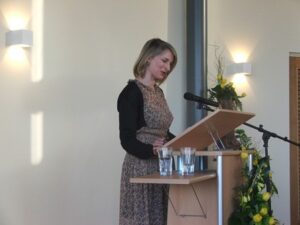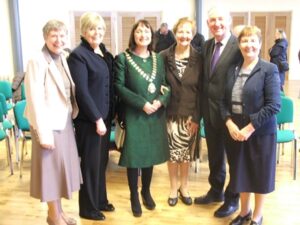Review: Brigit
by Peter Crawley for the Irish Times

 Today's gathering was different. I was there with about ten other people for a Roman Catholic Womanpriest led mass, officiated by Rev. Dr. Victoria (Vikki) Marie for the Our Lady of Guadalupe Tonantzin Community.
Today's gathering was different. I was there with about ten other people for a Roman Catholic Womanpriest led mass, officiated by Rev. Dr. Victoria (Vikki) Marie for the Our Lady of Guadalupe Tonantzin Community. ssed the Centre. The tape cutting ceremony was followed by a musical celebration which included music, song and dance as guests were entertained by Eimear, Luka Bloom and local musicians and dancers.
ssed the Centre. The tape cutting ceremony was followed by a musical celebration which included music, song and dance as guests were entertained by Eimear, Luka Bloom and local musicians and dancers. d went on to say how the Solas Bhride Centre “will undoubtedly help us to remember that heritage, reflecting our place in society and in the world, while considering our future path; both personally and as a community… This new facility will develop not only into a national location for spirituality and reflection, but also internationally giving our local and wider community and visitors to the area a unique experience, particularly in the areas of education, ecology, spirituality and healing”.
d went on to say how the Solas Bhride Centre “will undoubtedly help us to remember that heritage, reflecting our place in society and in the world, while considering our future path; both personally and as a community… This new facility will develop not only into a national location for spirituality and reflection, but also internationally giving our local and wider community and visitors to the area a unique experience, particularly in the areas of education, ecology, spirituality and healing”. Brian O’Brien of Solearth Ecological Architecture who designed the unique ecologically sustainable Spirituality Centre, in the shape of a St. Brigid’s cross, with the centre of the cross featuring an internal garden and circular and semi-circular rooms, Manley Construction Ltd. who built the Centre and have already received two national awards for the building. A special acknowledgement to the Quantity Surveyor, George Fitzpatrick, Gilltown, Kilcullen, for delivering the project within budget.
Brian O’Brien of Solearth Ecological Architecture who designed the unique ecologically sustainable Spirituality Centre, in the shape of a St. Brigid’s cross, with the centre of the cross featuring an internal garden and circular and semi-circular rooms, Manley Construction Ltd. who built the Centre and have already received two national awards for the building. A special acknowledgement to the Quantity Surveyor, George Fitzpatrick, Gilltown, Kilcullen, for delivering the project within budget.Brigit of the mantles, Brigit of the peat-heap, Brigit of the twining hair, Brigit of the augury.
Brigit of the white feet, Brigit of the calmness, Brigit of the white palms, Brigit of the kine.
Brigit, woman-comrade, Brigit of the peat-heap, Brigit, woman-helper, Brigit, woman mild.
Brigit, own tress of Mary, Brigit, Nurse of Christ, Each day and each night That I say the Descent of Brigit,
I shall not be slain, I shall not be wounded, I shall not be put in cell, I shall not be gashed,
I shall not be torn in sunder, I shall not be despoiled, I shall not be down-trodden,
I shall not be made naked, I shall not be rent, Nor will Christ Leave me forgotten
Nor sun shall burn me, Nor fire shall burn me, Nor beam shall burn me, Nor moon shall burn me.
Nor river shall drown me, Nor brine shall drown me, Nor flood shall drown me, Nor water shall drown me.
Nightmare shall not lie on me, Black sleep shall not lie on me, Spell sleep shall not lie on me, “ Luaths-luis” shall not lie on me.
I am under the keeping Of my Saint Mary, My companion, beloved Brigit.
From Carmina Gadelica, Hymns and Incantations, in Gaelic with English translations, Volume III. Collected byAlexander Carmichael.